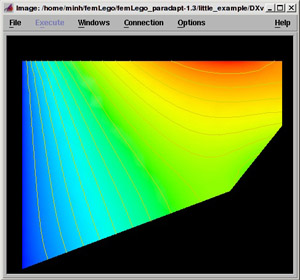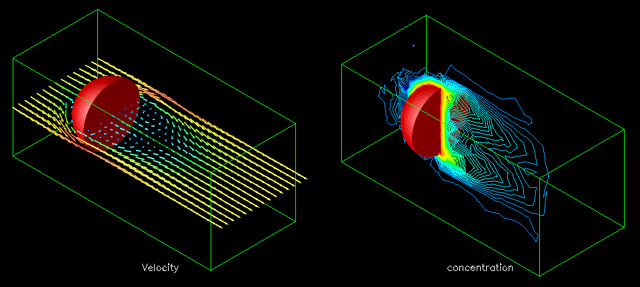A few examples are included in femLego directory. They are found at the relative paths shown below.
1. First example
 This is a small example that can be found at the directory ./femLego_dist/little_example. It is suitable to illustrate the general idea, and to serve as a template for other problems. The worksheet, example.mws, is structured and commented so that it should be reasonably self explanatory.
This is a small example that can be found at the directory ./femLego_dist/little_example. It is suitable to illustrate the general idea, and to serve as a template for other problems. The worksheet, example.mws, is structured and commented so that it should be reasonably self explanatory.
The two equations that are solved are one Laplacian, and one diffusion equation with a source term. A 2D triangular mesh (gmsh.msh) is included together with a geometry file (mesh.geo) that you can used for gmsh input file to generate the mesh input file for femLego.
More detailed information about the content of little_example is given here:
2. Navier-Stokes
Here the time dependent Navier-Stokes equations for viscous fluid flow are solved in 2D, using a scheme by Guermond and Quartapelle, along with a pressure stabilization term. The two velocity components and pressure are computed in time. The curl of the velocity field, the vorticity, is also computed, as well as a scalar quantity that is convected with the flow.
The geometry is a flow past a cylinder, which exhibits the well known periodic shedding of vortices behind the cylinder. The mesh is contained in the file gmsh.msh. The scalar quantity is diffusing out from the cylinder and is convected away.

3. 3D example
This is intended as a first 3D example, that can serve as a template for 3D problems. The equations are the extension of equations in "Navier Stokes" example to three dimension version. The geometry is a tunnel with a small half sphere inside.
A 3D tetrahedral mesh is read from gmsh.msh. This mesh file is produced by a freeware mesh generation program GMSH.
Boundary conditions are specified in boundary.ini, with one set of conditions per face ID, as specified in mesh.geo as a physical surface ID. boundary.ini is supplied by the user and can be edited as desired. In this case there are six entries, for the faces of the tunnel, and a seventh for the surface of the internal half sphere.
The file DXViewer.net specifies a network for OpenDX, which can be used to view the ouput in the out*.dx files.
